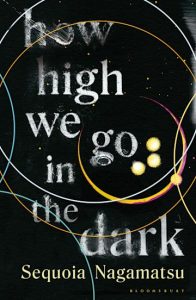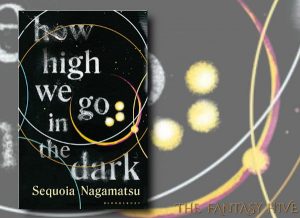HOW HIGH WE GO IN THE DARK by Sequoia Nagamatsu (BOOK REVIEW)
“Once, I asked her what she was doing, and she said she was just trying to keep track of it all because it didn’t seem like anybody else noticed or cared that we kept making the same mistakes, that hate in a neighborhood or injustice in a state ran like poison through veins, until another ice shelf collapsed or another animal went extinct. Everything is connected, she’d say. And I’d tell her, You’re only one person and you only have one life.”
Sequoia Nagamatsu’s How High We Go In The Dark (2022) is a remarkable work of speculative fiction, an urgent exploration of grief and loss in the wake of a global pandemic. Written in the years immediately preceding the Covid-19 outbreak, Nagamatsu’s exploration of the long-term ramifications of societies negotiating grief, trauma and survivor’s guilt feels both chillingly prescient and incredibly relevant. Told in a series of interlocking mosaic narratives spanning from the immediate outbreak and aftermath to centuries in the future, Nagamatsu makes the profound consequences across society tangible by focusing on the lived daily realities of his various characters. How High We Go In The Dark is frequently devastating, unflinchingly exploring the rawness of grief. It is often a bleak and distressing read, an attempt to come to grips with trauma and loss across generational time. But in its remarkable scope and sheer emotional honesty, it is an essential work of fiction, and one that demonstrates how speculative fiction is frequently the genre best placed to help us process something as large and as devastating as the pandemic. That this is Nagamatsu’s first novel only further demonstrates his enviable skill and ambition.
 How High We Go In The Dark begins with the discovery of the thirty-thousand-year-old remains of a girl buried in the permafrost of Siberia. Dr. Cliff Miyashiro travels to the site following the death of his daughter after making the discovery, only to find himself at the centre of an outbreak of an ancient virus buried for millennia under the ice. The virus tears through the unprepared human population, resulting in a devastating global pandemic, killing millions and putting survivors in comas. Through a series of interconnected narratives, Nagamatsu explores what life is like for the people who live through the plague and those who come after, dealing with various forms of intergenerational grief and trauma. Skip, an aspiring comedian, takes a job in a euthanasia park for terminally ill children and falls in love with the mother of a dying child. David, a research scientist growing replacement human organs inside pigs to save those with the disease, discovers one of his pigs has gained the ability to communicate. Dennis, a deadbeat son trying to ignore his dying mother, works in a death hotel where people can visit the bodies of their lost loved ones. A man struggling to bond with his son after the death of his wife repairs people’s robotic dogs, programmed to retain snapshots of their loved ones’ personalities. Aubrey works in a lab studying the progress of the disease, her collapsing relationship with her husband contrasted with the bittersweet friendship she strikes up with one of her dying subjects. As the book progresses, it gets more speculative as it drives further into the future. We meet Brian, a brilliant physicist, who whilst searching for a way for humanity to escape earth accidentally opened a wormhole inside his own head. The crew of the U.S.S. Yamato abandons Earth to search for a new home beyond the stars, time dilation due to relativity meaning that by the time they reach their new home their friends and relatives back on Earth are long dead and a cure for the plague has already been found. Akira, one of the many young underemployed, strikes up a friendship with a woman who is dying from long-term complications of the virus, entirely in the virtual world. And an alien intelligence reflects on the ancient mistake that led to the virus being on Earth in the first place.
How High We Go In The Dark begins with the discovery of the thirty-thousand-year-old remains of a girl buried in the permafrost of Siberia. Dr. Cliff Miyashiro travels to the site following the death of his daughter after making the discovery, only to find himself at the centre of an outbreak of an ancient virus buried for millennia under the ice. The virus tears through the unprepared human population, resulting in a devastating global pandemic, killing millions and putting survivors in comas. Through a series of interconnected narratives, Nagamatsu explores what life is like for the people who live through the plague and those who come after, dealing with various forms of intergenerational grief and trauma. Skip, an aspiring comedian, takes a job in a euthanasia park for terminally ill children and falls in love with the mother of a dying child. David, a research scientist growing replacement human organs inside pigs to save those with the disease, discovers one of his pigs has gained the ability to communicate. Dennis, a deadbeat son trying to ignore his dying mother, works in a death hotel where people can visit the bodies of their lost loved ones. A man struggling to bond with his son after the death of his wife repairs people’s robotic dogs, programmed to retain snapshots of their loved ones’ personalities. Aubrey works in a lab studying the progress of the disease, her collapsing relationship with her husband contrasted with the bittersweet friendship she strikes up with one of her dying subjects. As the book progresses, it gets more speculative as it drives further into the future. We meet Brian, a brilliant physicist, who whilst searching for a way for humanity to escape earth accidentally opened a wormhole inside his own head. The crew of the U.S.S. Yamato abandons Earth to search for a new home beyond the stars, time dilation due to relativity meaning that by the time they reach their new home their friends and relatives back on Earth are long dead and a cure for the plague has already been found. Akira, one of the many young underemployed, strikes up a friendship with a woman who is dying from long-term complications of the virus, entirely in the virtual world. And an alien intelligence reflects on the ancient mistake that led to the virus being on Earth in the first place.
All of the stories work as standalone little vignettes, showing what life, grieving and death look and feel like at various points in the novel’s future history. However, emphasising the novel’s underlying theme of the connections that exist between all of humanity even at the most trying of times, characters from previous stories crop up as background characters in later stories, as other characters’ friends, relations, ancestors, or missed encounters. Thus Nagamatsu paints a picture of the web of interconnections that draw us together through the shared experiences of suffering and grief. How High We Go In The Dark is such a necessary book because it’s about how we as a society and as people react to something like a pandemic. Nagamatsu portrays a society in which the virus exacerbates and acts on the divisions between the haves and the have-nots, examining a wide range of humanity across different classes and backgrounds, and showing how their circumstances shape how the pandemic effects their lives. The relevance of this feels particularly pertinent following two years of the ongoing Covid-19 pandemic, the long-term consequences and fallout of which we as a society are doing our best to ignore. Nagamatsu shows that this is impossible, that these experiences will have shaped our present and our future in ways we are only beginning to imagine. Much speculative fiction does not spend a lot of time thinking about how we conceptualise death, how the rituals of grieving and remembering those we have lost grow and change over time. How High We Go In The Dark focuses explicitly on this, imagining how people and their beliefs change when confronted with death, loss and suffering on such magnitude. It is also a novel that ponders about the human soul, the metaphysical aspects of what happens to us when we die, again in new and intriguing ways that challenge our perceptions of humanity.
All this might make How High We Go In The Dark sound like an incredibly bleak book. There’s no denying that it is explicitly dealing with very heavy subject matters, and Nagamatsu does not shy away from exploring grief and death at their rawness. Yet there is a real warmth and humanity to the book. Nagamatsu’s characters are wonderfully drawn and fleshed out, real and believable people struggling to overcome their own personal flaws and the horrendous circumstances they find themselves in. He writes incredibly movingly but never mawkishly, making many of the sections of the book – in particular the section at the euthanasia park – utterly devastating. But the novel always returns to the central humanity of its characters, of people trying to live their lives the best they can under ridiculous amounts of pressure. It is a novel about death that also celebrates all the highs and lows of being alive, with all the love and loss celebrated in equal measure. Whether the characters involved are humans, uplifted pigs or immortal shapeshifting aliens, they all share a core of warmth and nobleness that says, isn’t just being alive a remarkable thing?
Nagamatsu’s timely, moving and challenging novel is surely one of the highlights in fiction this year, across whatever genre you may read. I will genuinely be surprised not to see it on multiple award ballots. Nagamatsu is a talented and ambitious writer who I hope we will hear more from soon.

